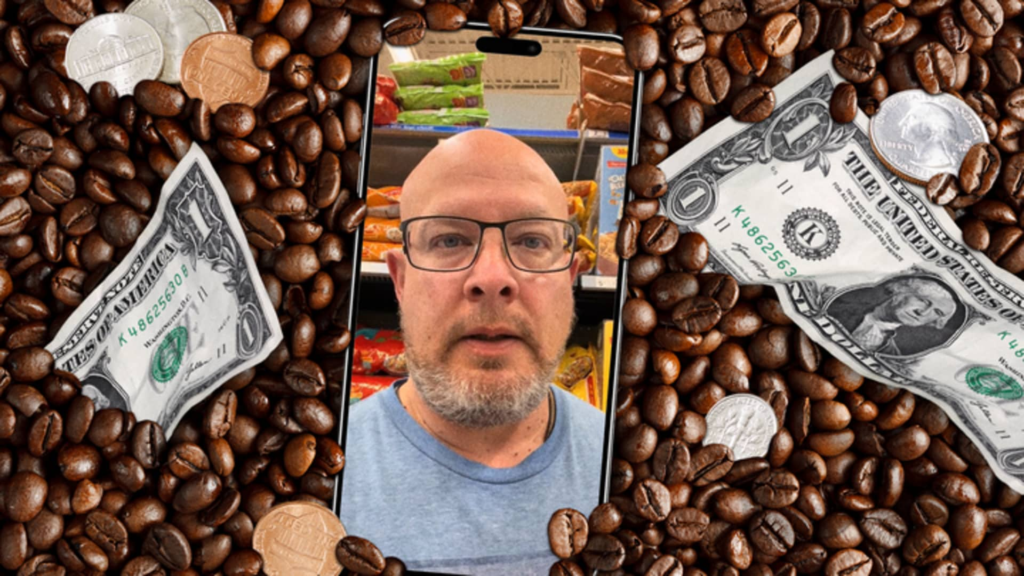In August 2025, Chuck Smith went to buy coffee at a Walmart in Rochester, Indiana. But something seemed off.
“I bent down to pick up the coffee and happened to notice the price,” he tells CNBC Make It. “I thought, ‘Do I spend that much money every time I buy the coffee?’ It really caught me off guard.”
He checked his receipts in the Walmart app and found that the 38.2-ounce Maxwell House he’d been buying for years rang up at $21.44 — nearly double the $12.94 he paid less than a year earlier, in October 2024.
Smith, 52, filmed a short TikTok video in the Walmart aisle comparing the two prices: “This is ridiculous,” he says in the video. Within days, it had tens of thousands of views.
Walmart did not respond to a request for comment, and Kraft Heinz, the maker of Maxwell House, did not provide a statement by publication time.
“It wasn’t meant to be a political statement,” Smith says. “It was just me in the moment. I think it captured what a lot of folks are feeling.”
The price jump Smith saw isn’t unusual. Coffee has become markedly more expensive over the past year as poor harvests and higher import duties have helped push the cost of retail coffee 41% higher since September 2024 alone.
Why coffee prices are rising
Coffee prices have surged over the past year as droughts and heavy rain have reduced harvests in major growing countries like Brazil and Vietnam.
Arabica futures — the global benchmark for coffee — briefly reached an all-time intraday high of $4.38 a pound in October, up roughly 50% since August, according to Intercontinental Exchange data.
Those pressures are filtering down to store shelves. In the U.S., the average retail price for ground roast coffee sold on store shelves reached $9.14 per pound in September — up 41% from a year earlier, according to Bureau of Labor Statistics data.
The Trump administration’s new tariffs have added another layer of cost. Imports from Brazil now face a 50% duty, while other major suppliers like Vietnam and Indonesia face tariffs of 20% and 19%, respectively, according to the National Coffee Association.
Since April, when tariffs first took effect, coffee prices have jumped 9.6% — the sharpest midyear rise in at least a decade, compared with an average increase of less than 1% over that span, according to Bureau of Labor Statistics data.
Where rising coffee prices are hitting customers hardest
For shoppers like Smith, relief isn’t likely soon — futures prices suggest retail costs could stay elevated for months.
Plus, coffee producers across the market have been increasing prices. Nestlé has raised prices across its coffee portfolio this year, including Nespresso products, in part to offset higher bean costs, the company said. J.M. Smucker, maker of Folgers, has raised coffee prices twice so far this year in response to higher sourcing costs, according prepared remarks from the company’s latest earnings call.
It’s not just grocery-store coffee that’s gotten pricier. The cost of a regular cup bought in cafes and restaurants has risen about 8%, from $3.26 to $3.52 since February 2024 — just before the recent ramp-up in wholesale prices — according to data from Toast, which tracks sales across tens of thousands of coffee shops and restaurants nationwide.
That said, price increases at cafés and restaurants often lag the wholesale market, since operators typically buy beans under contract or adjust menus gradually to avoid alienating price-sensitive customers. Many businesses lean on food sales or pricier drinks to help offset higher bean costs, according to trade publication Coffee Intelligence.
While poor harvests have pushed prices higher, “supply is likely to increase next year, alleviating some of these pressures,” says Michael Cramer, founder of specialty coffee retailer Lardera Coffee Roasters.
“However, the tariffs may remain, causing consumers to pay more for coffee unless cooler heads prevail and recognize that coffee is not a strategic industry that requires sheltering, and that tariffing its imports is not in the country’s best interests,” he says.
Want to level up your AI skills? Sign up for Smarter by CNBC Make It’s new online course, How To Use AI To Communicate Better At Work. Get specific prompts to optimize emails, memos and presentations for tone, context and audience.
Plus, sign up for CNBC Make It’s newsletter to get tips and tricks for success at work, with money and in life, and request to join our exclusive community on LinkedIn to connect with experts and peers.


